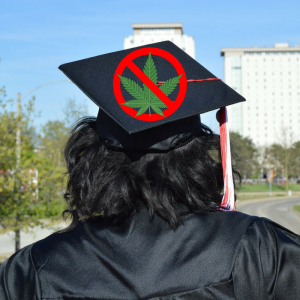 What’s a medical marijuana card-holding college student to do when they are required to live in on-campus housing but their medicine is banned from the premises?
What’s a medical marijuana card-holding college student to do when they are required to live in on-campus housing but their medicine is banned from the premises?
Apparently, choose between suffering from their illness or face disciplinary action, at least according to the majority of University policy.
In Washington DC, marijuana is legal to for those over the age of 21 to possess, transfer (exchange with no currency involved), and grow up to two ounces of marijuana in their homes and available to buy from a dispensary for medical use per a doctor’s recommendation. However, given its treatment on college campuses in the area, you would have no idea.
For example, at American University, their code for student conduct clearly states the punishable offenses for “alcohol and illegal drugs” (despite the fact that cannabis has been legalized for medical and recreational use for adults 21+) include:
- To use or possess any illegal drug (including medical marijuana) or drug paraphernalia in the residence halls.
- To sell, manufacture, or distribute any illegal drug (including medical marijuana) or drug paraphernalia in the residence halls.
- To knowingly and voluntarily be in the presence of any illegal drug (including medical marijuana) or drug paraphernalia in the residence halls.
At The George Washington University, their policy on medical marijuana is less clear. Their policy for medical marijuana is not listed in their Code for Student Conduct, and when asked for clarification on the matter, the administration declined to respond.
The code for student conduct does say, however, that students caught using, possessing, and distributing marijuana face a minimum $ 50 fine, mandatory drug education classes, and possible eviction from housing. If there’s an intent to distribute, students face suspension or expulsion.
Alcohol penalties at the school, on the other hand, are significantly less harsh. The penalty for consumption and possession is parental notification, and in subsequent offenses, students could face a possible fine or alcohol education classes.
In addition to this, GW provides an Alcohol Medical Amnesty Policy, wherein underage, intoxicated students can receive a penalty-free ride to the hospital in a student-run ambulance for their first offense. Subsequent offenses receive harsher penalties each time, though it takes much longer for a student to reach serious disciplinary action than for marijuana users, who are harshly penalized for their first time.
So why do these schools remain so behind the times? Why is marijuana classified so much more harshly than alcohol– which kills over 1800 students per year and is heavily associated with sexual assault?
The answer comes down to the same reason a college makes any decision: funding.
According to the Drug-Free Schools and Communities Act of 1989 (that’s right, 1989), the use of “drugs” (a vague term that somehow excludes alcohol and caffeine) must be disallowed by schools, universities, and colleges. If they fail to comply, they become ineligible for federal funding.
Until we can overcome the pervasive stereotype of cannabis users as sluggish, lazy, stupid, and unconcerned, it looks like students will have to continue to live in the impossible bind between relieving their illnesses and violating school policy.


